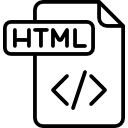HTML

HyperText Markup Language, commonly referred to as HTML, is the standard markup language used to create web pages. Along with CSS, and JavaScript, HTML is a cornerstone technology used to create web pages, as well as to create user interfaces for mobile and web applications. Web browsers can read HTML files and render them into visible or audible web pages.
HTML describes the structure of a website semantically along with cues for presentation, making it a markup language, rather than a programming language.[2]
Introduction[edit]
Content gratefully used with permission : [3]
List of input types[edit]
The HTML <input> element is used to create interactive controls for web-based forms in order to accept data from the user.
Like almost all other HTML elements, input type has a wide range of attributes. Input types have both HTML global attributes and specific attributes. Remember this.
How an <input> works varies considerably depending on the value of its type attribute, hence the different types are covered in their own separate reference pages. If this attributes is not specified, the default type adopted type is text. [4]
Click here the Mozilla documentation page with links to each input type
- password
- submit
- button
- text
- textarea
- range
- radio
- checkbox
- datalist
- search
- url
- tel
- number
- range
- date
- month
- week
- time
- datetime-local
- color
- hidden
Helpful resources[edit]
- Good site for choosing HTML colors
- Excellent reference for HTML
- Specification for HTML 5
- Official HTML documentation
- A list of HTML elements